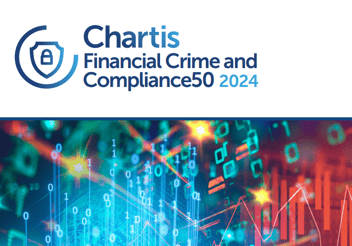$800 billion - $2 trillion US dollars. That’s how much the UN estimates is laundered annually. It’s about 2 - 5% of the global GDP, which is why Anti-Money Laundering (AML) regulations are ever-changing, and financial institutions must continually evolve.
As a result, the landscape of compliance within the sector has never been more fluid. Changes to regulations mean the industry has to modify its approach, but by using technology to enhance AML checks and processes, the financial sector can keep on top of compliance and maintain great customer experiences.
That’s especially true in the field of monitoring and screening, where we’ve seen big regulatory changes in both the U.S. and the EU.
Here’s what you need to know about both the 5AMLD and the New York 504 ‘Final Rule’ – and what they mean for your institution…
The NYSDFS Part 504 (Final Rule)
Effective January 1, 2017, the New York 504 “Final Rule” (NYSDFS part 504) sets out stringent conditions that apply to managing risk around money laundering.
The rule is an extension to New York State’s existing Anti-Money Laundering (AML) regulation, but better reflects changes in technology, and now the scope of the rule applies to any organization that falls under the wide remit of regulated financial companies.
The 504 rule requires annual certification for compliance, and there are stringent requirements – at board level – to achieve that certification.
Part 504.3, “Transaction Monitoring and Filtering Program Requirements” of the regulation, accepts both a manual and automated approach to managing AML risk. But here’s the thing: the rule focuses on the quality of the monitoring outcome, which is why we believe that using automation through machine learning is best practice.
Platforms based on machine learning offer real-time analytics, which is vital in spotting fraud quickly. Machine Learning, for example, is used in sanction screening with options such as “fuzzy matching” – able to provide the automation referenced in the 504 rule, which states that “technology used in this area may be based on automated tools that develop matching algorithms, such as those that use various forms of so‐called “fuzzy logic” and culture‐based name conventions to match names.”
So, while the NYSDFS part 504 rule doesn’t mandate any particular tech, the use of smarter, artificial intelligence-based solutions does offer a more streamlined way to meet the stringent requirements of the NYSDFS part 504.
The Fifth Anti-Money Laundering Directive (5AMLD)
The New York 504 rule future-proofed AML monitoring and screening, and it seems to have set a precedent across the world. In turn, the EU recently made several key changes to its previous AML regulation, known as the Fourth Anti-Money Laundering Directive (4AMLD).
The resulting Fifth Anti-Money Laundering Directive regulation (5AMLD) came into force on January 10, 2020, reflecting a number of changes in the financial landscape.
This also includes provision for new technologies to manage risk in a climate of changing consumer behavior, and to facilitate consumer expectations of seamless transactions. 5AMLD also brings the law in line with other regulatory updates.
The EU Commission made this statement about the updated directive:
“Amending the Fourth Anti-Money Laundering Directive, intends to complement the existing preventive legal framework in place in the Union, by setting out additional measures to better counter the financing of terrorism and to ensure increased transparency of financial transactions and legal entities.”
In a statement, the EU set out the main new requisites/changes covered by the 5AMLD:
Enhance the powers of EU Financial Intelligence Units (FIU) and facilitating their increasing transparency on who really owns companies and trusts by establishing beneficial ownership registers
- This pulls virtual currencies (i.e. cryptocurrencies) within the scope of the directive for the first time. Importantly for AML, the directive enforces the registration of cryptocurrency services with financial authorities. 5AMLD also extends the powers to FIUs to request the personal details of cryptocurrency owners.
- High–value goods transactions, of over 10,000 euros, are subject to AML/CFT reporting obligations and Customer Due Diligence (CDD) measures during a transaction.
- EU states are required to make their Ultimate Beneficial Owner (UBO) lists inter-connected across countries and to strengthen their verification mechanisms.
Prevent risks associated with the use of virtual currencies for terrorist financing and limiting the use of prepaid cards
- See also additional powers of the FIU.
- Prepaid cards are an ideal medium for criminals to move money. The 5AMLD transaction limit, before identification is required, has dropped from 250 euros (4AMLD) to 150 euros in 5AMLD. If a transaction is remote and anonymous, the limit drops further, to 50 euros. A prepaid card issued outside the EU is prohibited for transactions unless issued in a territory with acceptable AML/CFT standards.
Improve the safeguards for financial transactions to and from high-risk third countries
- High-risk countries are covered by the 5AMLD with the requirement for mandatory and Enhanced Due Diligence (EDD) on customers from these countries.
- The 5AMLD requires Politically Exposed Persons (PEP) lists in member states to be made publicly available; the EU has an EU-level PEP list. The individuals on the lists may be politically exposed by the GDPR’s ‘legitimate interest’ clause which is used as a legal basis.
Enhance the access of Financial Intelligence Units to information, including centralized bank account registers. Ensure centralized national bank and payment account registers or central data retrieval systems in all Member States.
- Centralized bank account registers or central data retrieval systems offer a mechanism to associate multiple national bank accounts that belong to an individual. This provides a means for law enforcement to perform financial investigations.
Anti-Money Laundering: How smart technologies can help
We all know that having effective and modernized financial regulations is more vital now than ever before. After all, as our payment mechanisms become increasingly seamless to meet customer expectations, doors of opportunity open for cyber-criminals to exploit.
Thankfully, regulators recognize this, and have made adjustments to bring laws and directives into the 21st century. Checks on identification, sanction screening, and new transaction rules are strictly required by AML regulations, for instance, but they’re all made possible by the emergence of new technologies.
Smart platforms utilizing artificial intelligence methods such as machine learning, provide the basis for achieving compliance with AML laws whilst retaining a great customer experience – and that’s exactly what we offer at Eastnets.
To find out how our use of AI and the blockchain can help provide you with the most up to date security, compliance and AML assurances possible, head over to our Innovation section.





